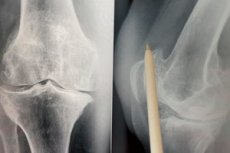New publications
Osteoarthritis is associated with accelerated development of severe chronic diseases
Last reviewed: 02.07.2025

All iLive content is medically reviewed or fact checked to ensure as much factual accuracy as possible.
We have strict sourcing guidelines and only link to reputable media sites, academic research institutions and, whenever possible, medically peer reviewed studies. Note that the numbers in parentheses ([1], [2], etc.) are clickable links to these studies.
If you feel that any of our content is inaccurate, out-of-date, or otherwise questionable, please select it and press Ctrl + Enter.

Osteoarthritis, a condition in which the protective cartilage at the ends of bones breaks down, may more than double the risk of rapid progression to a buildup of severe long-term disease (multimorbidity), according to a 20-year study published in the journal RMD Open.
Also, according to the study results, there are four different rates of progression to multimorbidity.
Chronically low levels of physical activity, a high-calorie diet and chronic low-level inflammation may help explain the link between osteoarthritis and the risk of developing other long-term diseases, researchers suggest.
Although the exact causes of osteoarthritis are unknown, injury, age, family history and female gender are thought to be factors that contribute to the development of this disease, which affects more than 500 million people worldwide.
About 7 in 10 people with osteoarthritis likely have other long-term conditions, but it's unclear how quickly they develop and how severe they are, researchers say.
To find out, they used continuous health data for the Skåne region of Sweden (around 1.4 million inhabitants) and extracted diagnoses for osteoarthritis and 67 common long-term conditions.
They focused on those who were 40 years or older on December 31, 2007, had lived in the region since 1998 and had their osteoarthritis first diagnosed between 2008 and 2009. This included 9,846 people with a median age of 66 (58% women).
Each of these cases was matched with two age- and sex-matched individuals who did not have osteoarthritis (reference group), yielding a total of 19,692 individuals.
The cumulative number of diseases (multimorbidity) was tracked among cases and their matches since 1998 until death, relocation outside the region, or until the end of 2019, whichever came first.
Between 2008 and 2009, 5,318 people were newly diagnosed with knee osteoarthritis, 2,479 with hip osteoarthritis, 988 with hand osteoarthritis, 714 with other joint osteoarthritis, and 499 with generalized osteoarthritis.
Some 1,296 people (cases and reference group participants) did not develop any other long-term illnesses. But 28,242 people did.
Between 1998 and 2019, four distinct progression patterns emerged: moderate multimorbidity with late progression (class 1); moderate multimorbidity with early progression (class 2); moderate multimorbidity (class 3); and severe multimorbidity (class 4).
In 1998, the average number of long-term conditions was low (1 or none) in all four classes. And those in class 1 progressed to developing multiple long-term conditions the slowest and had the lowest cumulative number by the end of the tracking period, averaging about 3.
There was almost no development of long-term disease for about 10 years among those in this category, after which there was a more rapid progression that brought them into line with those in class 2. In general, those in classes 1 and 2 were younger and better educated.
Those in class 4, on the other hand, progressed the fastest and had the highest cumulative number of about 10 long-term conditions by the end of the tracking period.
The Global Burden of Disease (GBD) study disability rate was used to estimate the severity of each long-term condition, excluding osteoarthritis.
Disability levels reflected the categorizations. They were lowest among those in Class 1 and highest among those in Class 4, where more than half (57%) of participants had died by the end of the follow-up period.
The prevalence of osteoarthritis was also lowest among those in class 1 (29%) and highest among those in class 4 (42%). And osteoarthritis was associated with a 29% increased risk of being in class 1, but more than doubling the risk for being in class 4.
However, having osteoarthritis alone was a poor predictor of membership in either class, the results showed.
"Although this study did not aim to examine the timing of [osteoarthritis] diagnosis in relation to multimorbidity, our results suggest that [it] may, in some cases, precede multimorbidity, as seen in the class with moderate multimorbidity and late progression, whereas in others [it] is diagnosed when multimorbidity is already established," the researchers explain.
"These results suggest that [osteoarthritis] is part of a disease continuum where [it] and other chronic conditions contribute to the development of more severe multimorbidity," they add.
Age is a critical factor in the development of long-term disease, the researchers note. "However, the correlation between [osteoarthritis] and multimorbidity remained unchanged, indicating that [its] association with multimorbidity extends beyond age," they write.
This is an observational study, and as such, no definitive conclusions can be drawn about causal factors. And the researchers acknowledge several limitations of their findings, including the fact that the role of physical activity, diet, and body weight were not accounted for across classes.
"Low physical activity, high-calorie diet and low-level inflammation have all been suggested as possible links between [osteoarthritis] and other chronic diseases and might partly explain the observed associations," they suggest.
